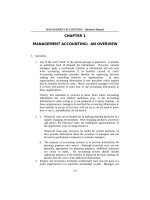International interviewing and counseling 9th ivey chapter 01
Bạn đang xem bản rút gọn của tài liệu. Xem và tải ngay bản đầy đủ của tài liệu tại đây (458.2 KB, 27 trang )
Intentional Interviewing and Counseling:
Facilitating Client Development in a
Multicultural Society
9th Edition
Allen E. Ivey
Mary Bradford Ivey
Carlos P. Zalaquett
Copyright © 2018 Cengage Learning. All Rights Reserved.
Chapter 1
Intentional Interviewing,
Counseling, and Psychotherapy
Copyright © 2018 Cengage Learning. All Rights Reserved.
Chapter Goals and Competency Objectives
Awareness and Knowledge
▲
Define and discuss similarities and differences among interviewing, counseling, and psychotherapy and review who actually conducts most of the helping sessions.
This may be surprising and rewarding.
▲
Explore the session as both science and art. We ask you to reflect on yourself as a potential helper. While science undergirds what is said here, you, as an
independent artist, will find your own integration of knowledge and skills.
▲
Identify intentionality and cultural intentionality as bases for increasing your flexibility to reach a wide variety of clients facing an endless array of concerns, issues,
and challenges.
▲
Examine key goals of counseling and psychotherapy: self-actualization, resilience, and resolution of client issues.
▲
Consider the place of cutting-edge neuroscience in your work and in the future of counseling and psychotherapy.
▲
Identify the locations where counseling and psychotherapy are practiced.
Copyright © 2018 Cengage Learning. All Rights Reserved.
Chapter Goals and Competency Objectives (cont.)
Skills and Action
▲
The microskills hierarchy provides a foundation for interview action, not only in a beginning form but also in
conjunction with multiple theories and approaches to counseling and therapy, including person-centered, cognitive
behavioral therapy (CBT), crisis counseling, and many others.
▲
As your first practical exercise, record a counseling session demonstrating your natural style of communicating and
helping. This provides a baseline so that later you can examine how your counseling style may have changed and
grown during your time with this book. Practicing and developing a Portfolio of Competencies provide a summary and
journal of your experience.
Copyright © 2018 Cengage Learning. All Rights Reserved.
Introduction: Interviewing, Counseling, and Psychotherapy
Sienna:
“I wonder when I’ll be able to see Freddy [baby’s father] again. Mom works hard to keep him away from me. I
mean, I want him involved; he wants to be with me and the baby. But my mom wants me home. His mom
said she’s looking for a two-bedroom apartment so we could possibly live there, but I know my mom will
never go for it. She wants me to stay with her until I graduate from high school and, well, to be honest, so
that this never happens again [points to her belly].”
Copyright © 2018 Cengage Learning. All Rights Reserved.
Introduction: Interviewing, Counseling, and Psychotherapy (cont.)
Copyright © 2018 Cengage Learning. All Rights Reserved.
Defining Interviewing, Counseling, and Psychotherapy
▲
▲
The terms interviewing, counseling, and psychotherapy are used interchangeably in this textbook
▲
Coaching: “partnering with clients in a thought-provoking and creative process that inspires them to maximize their personal and
professional potential” (International Coach Federation, 2015).
▲
Counseling: an intensive and personal process for clients; focused on listening and developing strategies for change and
growth.
▲
Psychotherapy: focused on deep-seated and entrenched client issues, which often require more time for resolution. Many of the
skills and concepts of interviewing and counseling are also used in psychotherapy.
Interviewing: the process of gathering data, providing information and advice to clients, and suggesting workable alternatives for
resolving concerns.
Copyright © 2018 Cengage Learning. All Rights Reserved.
Cultural Intentionality: The Flexible, Aware, and Skilled Counselor
▲ The culturally intentional counselor acts with a sense of purpose (intention), skill, and respect for
the diversity of clients.
▲ You can facilitate client development in many ways.
▲ Cultural intentionality is a central goal.
▲ Be yourself, but
realize that to reach a wide variety of clients, you will need to be flexible, constantly changing behavior and
learning new ways of interacting with each client.
Copyright © 2018 Cengage Learning. All Rights Reserved.
Intentionality and Flexibility
▲ Intentionality speaks to the importance of being in the moment and responding flexibly to the
ever changing situations and needs of clients.
▲ Flexibility is basic to the art form of helping.
However, flexibility must be based on solid knowledge, awareness, and skills that turn into culturally intentional
action.
Cultural Intentionality
▲
Cultural intentionality: acting with a sense of capability and flexibly choosing an action from a range of alternatives.
▲
The interview occurs in a cultural context, and you need to be aware of diversity and differences.
▲
The culturally intentional individual has more than one action, thought, or behavior to choose from in responding to changing life
situations and diverse clients.
▲
The culturally intentional counselor can assist clients in addressing a variety of situations while honoring and respecting diverse
cultural beliefs.
▲
Without basic understanding of and sensitivity to a client’s uniqueness, you may fail to establish a relationship and achieve an
understanding of the client’s issues.
Copyright © 2018 Cengage Learning. All Rights Reserved.
Resilience and Self-Actualization
▲ Clients come to us feeling that are not functioning effectively and are focused on what’s wrong
with them. They are stressed, stuck, overwhelmed, and unable to act.
▲ They may have a negative self-concept; they may be depressed, or they may be full of anger
toward others.
▲ The focus on the negative is what we combat as we emphasize developing client intentionality,
resilience, and self-actualization.
Copyright © 2018 Cengage Learning. All Rights Reserved.
Resilience and Self-Actualization (cont.)
▲What does intentionality and flexibility mean for you as a counselor or therapist?
Clients will benefit and become stronger as they feel heard and respected.
They will become intentionally flexible with new ways to resolve their concerns.
Resolving specific immediate issues will help them feel empowered and facilitate further
action.
Copyright © 2018 Cengage Learning. All Rights Reserved.
Resilience
▲
Resilience is both a short-term and long-term goal of effective counseling and therapy.
▲
We seek to help clients resolve issues and concerns, handle future difficulties, become more competent, and respect
themselves more.
▲
Helping a client resolve an issue contributes to client resilience.
▲
Pointing out to clients that they are demonstrating resilience and ability helps facilitate longer-term success.
▲
Counseling’s ultimate goal is to teach self-healing—the capacity to use what is learned in counseling to resolve future
issues.
Copyright © 2018 Cengage Learning. All Rights Reserved.
Self-Actualization
▲
Self-actualization:
The curative force in psychotherapy—man’s tendency to actualize himself, to become his potentialities...to express and
activate all the capacities of the organism. (Rogers, 1961, pp. 350–351)
Intrinsic growth of what is already in the organism, or more accurately of what is the organism itself...self-actualization is
growth-motivated rather than deficiency-motivated. (Maslow, Frager, & Fadiman, 1987, p. 66)
▲
Closely related to both cultural intentionality and resilience.
▲
Rogers and Maslow believed in the ability of individuals to overcome challenges and take charge of their lives.
▲
Counseling and psychotherapy sessions are important for being in relation to others and their cultural/environmental
context.
Copyright © 2018 Cengage Learning. All Rights Reserved.
Microskills
▲ Microskills
Identify the behavioral foundations of intentional interviewing and counseling.
Are the communication skill units of the interview.
Clarify the “how” of all theories of counseling and therapy.
Provide alternatives to adapt to developmental and idiosyncratic characteristics of each client.
▲ You master these skills one by one and learn to integrate them into a well-formed session.
Copyright © 2018 Cengage Learning. All Rights Reserved.
The Microskills Hierarchy
▲ The microskills hierarchy summarizes the
successive steps of intentional counseling
and psychotherapy.
▲ The microskills rest on a base of ethics,
multicultural competence, neuroscience,
positive psychology, and resilience
Copyright © 2018 Cengage Learning. All Rights Reserved.
From Attending and Observation to Listening and Influencing
▲
Once you have mastered attending and observation skills, you will move up the microskills pyramid to the empathetic basic
listening skills of questioning, observation, encouraging, paraphrasing, summarizing, and reflecting feelings.
Once you have basic competence, you will be able to conduct a session using only listening skills.
The five-stage structure provides an empathetic relationship-story and strength-goals-restory-action framework for integrating microskills into a
complete counseling session.
▲
Afterward, you will encounter the influencing skills of interviewing, counseling, and therapy.
These are skills to help clients explore their personal or interpersonal conflicts.
Skills include focusing, empathic confrontation, interpretation/reframing and reflection of meaning, concrete action strategies (selfdisclosure and feedback, logical consequences, and some basics of decision counseling), providing information and direction for the
client, emphasizing stress management, psychoeducation, and therapeutic lifestyle changes.
Copyright © 2018 Cengage Learning. All Rights Reserved.
Mastering Microskills
▲ After mastering listening skills, the ability to conduct an interview using only your listening skills,
and the advanced skills, you will be prepared to consider alternative theories and models of
helping.
▲ The microskills are used in multiple forms of practice of counseling and psychotherapy.
For example, mastering the listening skills and the structure of the interview will give you a strong foundation
for learning person-centered theory and becoming a competent Rogerian.
The Microskills Hierarchy: The Listening and Action Skills of the Helping Process
▲ At the apex of the microskills pyramid, you will integrate skills to develop your own style of
counseling and therapy and transcendence.
Transcendence speaks to your capacity to go beyond yourself and successfully apply your newly mastered
skills to help others.
▲ As you gain expertise, you will learn that each client has a totally unique response to you and your
natural style.
Many clients will work well with you; some will require that you adapt to their style.
Having many alternatives ready to help your varying clientele is desirable.
Copyright © 2018 Cengage Learning. All Rights Reserved.
The Six-Step Learning Framework
The six-step learning framework:
1.
2.
3.
4.
5.
6.
Introduction. Focus on a single skill and identify it as a vital part of the holistic interview.
Awareness, Knowledge, and Skills. Read about the single skill or strategy and/or hear a lecture on the main points of effective use from your
instructor.
Observation. View skills via transcript and process analysis or watch a live or videotaped demonstration of microskills interviewing.
Multiple Applications. Review different applications of the skills, variations according to diversity and other dimensions, and additional ways in
which a skill or strategy can be used.
Action: Key Points and Practice. You can use video or audio recording for skill practice. Role-play practice with observers and feedback sheets
is also effective. Seek immediate feedback after each practice session. Use the Feedback Sheets.
Portfolio of Competencies and Personal Reflection. Develop and organize a summary of your interviewing, counseling, and psychotherapy
skills.
Copyright © 2018 Cengage Learning. All Rights Reserved.
Neuroscience and Neurobiology: Implications of Cutting-Edge Science for the Future of
Counseling and Psychotherapy
▲
We can not separate the body from the mind.
▲
Recent developments in brain science are changing the way we look at people and the influence of the environment on
individuals.
▲
The brain is constantly developing new neural networks. This is an example of brain plasticity and neurogenesis.
▲
Effective counseling and therapy can cause development of useful new neurons and neural connections in the brain.
▲
“Neuroplasticity can result in the wholesale remodeling of neural networks . . . a brain can rewire itself” (Schwartz & Begley, 2003,
p. 16).
▲
Counselors must increase their knowledge of neuroscience to communicate effectively with other mental health and medical
professionals.
Copyright © 2018 Cengage Learning. All Rights Reserved.
Neuroscience and Neurobiology: Implications of Cutting-Edge Science for the Future of
Counseling and Psychotherapy (cont.)
▲Eighty percent of medical issues involve the brain and stress (Ratey & Manning,
2014).
▲In most forms of counseling and psychotherapy practice, stress is considered an
underlying issue.
▲Stress management and therapeutic lifestyle changes are effective routes toward
both mental and physical health and necessary regardless of personal counseling
style or preferred theoretical approach.
▲Helping clients to manage stressful life events is critical in many styles
in client
intervention and treatment.
▲Strategies to help clients better cope with stress and manage stressful issues
include:
Listening to the client’s stories, establishing an empathic relationship, understanding the
client’s world, and focusing on wellness and strengths.
Copyright © 2018 Cengage Learning. All Rights Reserved.
Office, Community, Phone, and Internet: Where Do We Meet Clients?
Counseling, interviewing, and therapy can
Library
take place outside of the formal office:
School
Client’s home
Detention center or jail
Coffee shop
Client’s workplace
Park
Church
Basketball court
Restaurant
Street corner
Copyright © 2018 Cengage Learning. All Rights Reserved
Copyright © 2018 Cengage Learning. All Rights Reserved.
Office, Community, Phone, and Internet: Where Do We Meet Clients?
▲ Boundaries between counselor and client are changing.
▲ Many counselors are now using smartphones so clients can follow up with them and ask
questions.
However, this practice is fraught with practical and ethical issues.
▲ Counseling done online or by phone or Skype is not the same as a face-to-face
relationship.
Copyright © 2018 Cengage Learning. All Rights Reserved.
Your Natural Helping Style: Establishing Your Baseline
1.
Ask a friend or family member to role-play a client who must make a decision related to a concern, an issue, or an opportunity.
Interview or practice counseling that “client” for at least 15 minutes, using your own natural style.
2.
Read pages 28-30 of Chapter 2 and follow the ethical guidelines as you engage this volunteer client.
3.
A video recording, with feedback from colleagues and/or clients, is the preferred method for examination of your counseling style.
4.
When your interview concludes, ask the volunteer client to complete the Client Feedback Form (Box 1.3).
5.
Transcribe the video or audio tape for later study and analysis.
6.
What stands out for you from the client feedback form?
Copyright © 2018 Cengage Learning. All Rights Reserved.









